Growing chamomile isn’t as difficult as you may think, and they require minimal care. In this post I’ll show you everything you need to know in order to have the best success.
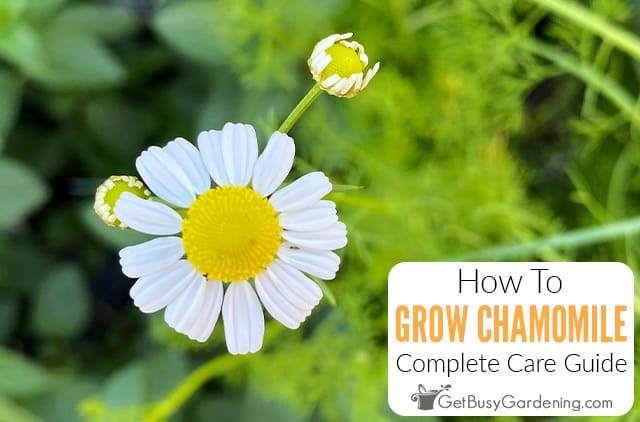
The low maintenance chamomile plant is a lovely flowering addition to any garden.
It’s perfect for beginners, who want to learn how to grow something easy and beautiful.
This guide is designed to teach you all about chamomile plant care, so anyone can enjoy this beneficial herb.
You’ll learn about providing the best soil, sun, and water, plus how to prune and pick the flowers to maximize its full potential.
Chamomile Plant Care Overview
| Scientific name: | Matricaria chamomilla |
| Classification: | Herb |
| Common names: | Chamomile |
| Hardiness: | Annual plant |
| Temperature: | 60-85°F |
| Flowers: | White with yellow centers, blooms spring through early fall |
| Light: | Full sun |
| Water: | Allow soil to dry between waterings, do not overwater |
| Humidity: | Average |
| Fertilizer: | General purpose plant food in spring and summer |
| Soil: | Fast-draining, fertile soil |
| Common pests: | Aphids, thrips, mealybugs |
Information About Chamomile
Chamomile is a flowering plant from the Asteraceae family, more commonly known as the aster or sunflower family.
It’s native to central and southern Europe, but is now grown around the world.
The green foliage produces daisy-like white flowers that have been used for medicinal purposes and tea for centuries.
It’s easy to grow, hardy, attractive to pollinators, and produces a pleasant floral aroma.
Different Types Of Chamomile Plants
There are two main types of chamomile you can grow. Their care requirements are very similar, but there are some growth differences.
- German (Matricaria chamomilla) is a self-seeding annual that grows on tall stems, and produces abundant small flowers in the summer. This is the one that’s most commonly used for harvesting purposes.
- Roman (Chamaemelum nobile) is a perennial in zones 4-9. It produces less flowers, and is more commonly used as a ground cover, lawn replacement, or edging than for the blooms.
Hardiness
Both forms of chamomile are very hardy, and grow well in a wide range of climates.
They tolerate freezing temperatures, highs up to 100°F, and are drought tolerant once established.
How Does Chamomile Grow?
German chamomile grows from shallow roots on upright stems that reach 2’ with plentiful small white flowers at the top.
The Roman variety has feathery foliage and spreads via rhizomatic roots. It averages between 3-6” tall with larger flowers.
Flowers
One of the main reasons for growing chamomile is for the flowers, which is the part of the plant that contains the most flavor.
Their cute little blossoms have yellow centers with white petals, and give off a pleasant, floral-apple aroma.
The blooms appear between late spring through early fall, and will produce seeds if left on the plant long enough.
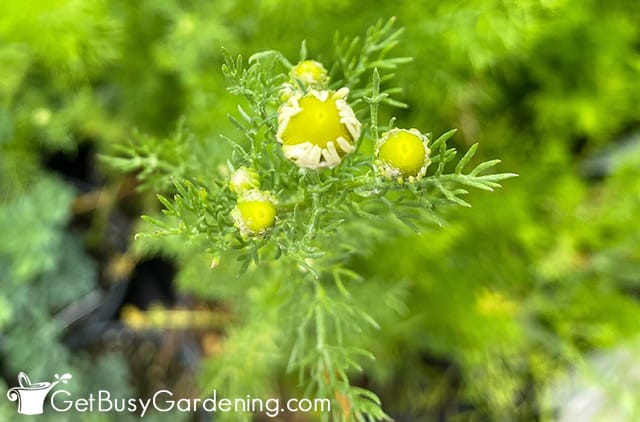
How To Grow Chamomile
Before we chat about how to care for it, first we should talk about when and where to grow chamomile. The right time and location can help it flourish.
Where To Grow Chamomile
Chamomile thrives in a wide variety of conditions. It can tolerate full sun to partial shade, and many different soil types.
Determining the perfect location will depend on the variety you plan to grow.
Roman will spread, and is best used as ground cover or path edging. While German grows well in garden beds or containers.
When To Plant Chamomile
Chamomile can be planted outdoors as soon as all chances of frost has passed in the spring.
The ideal soil temperature is 75°F, which you can check with a probe thermometer.
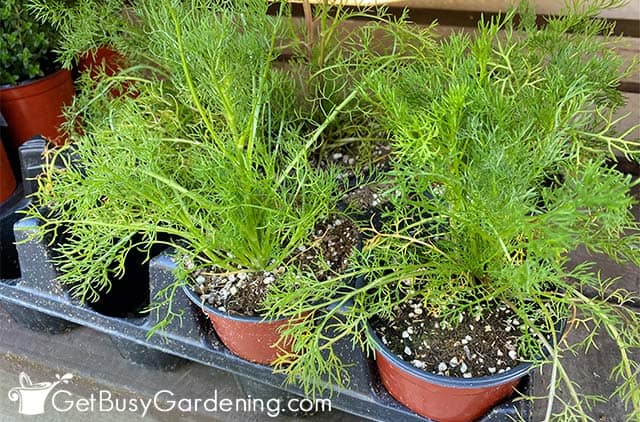
Chamomile Plant Care & Growing Instructions
Now that you have an ideal time and place in mind for growing it, it’s time to talk about chamomile plant care. Maintaing the ideal environment will help it thrive.
Sunlight
Chamomile will produce the most flowers and grows best when given 6-8 hours of full sun a day.
In warm climates that regularly see temperatures above 85°F, the afternoon sun can dry it out much faster. Provide shade during those hours to help it stay healthy.
Water
Young chamomile plants require even, consistent water, about 1” per week. Use a moisture gauge to make sure you’re giving it enough.
Once established, it can be watered much less. Let it dry out several inches down between drinks. In heat spells it may need more to keep it from drying out too fast.
Temperature
Chamomile can tolerate in a really wide range of temperatures, all the way from 30-100°F. But it will grow best when temperatures range between 60-85°F.
Heat approaching 90°F or more will stress the plant and cause it to stop growing. Provide shade and water more frequently during those periods.
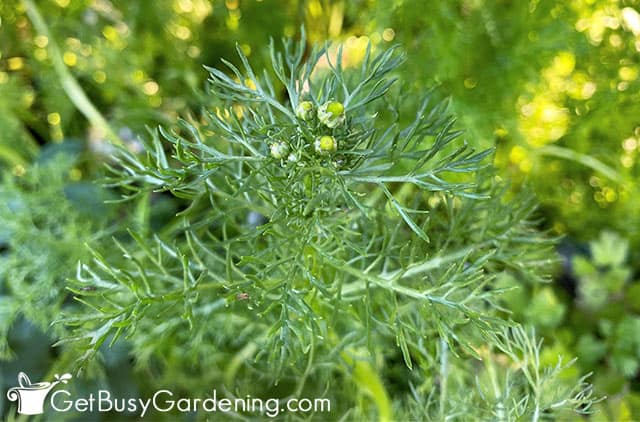
Fertilizer
Chamomile prefers not to be fertilized in most cases. Too much can cause rapid growth that will reduce the flavor of the flowers.
At most one application of a diluted, balanced fertilizer in the spring and summer is all they’ll require.
Compost tea or fish emulsion are great liquid options, or you can use slow-release granules if you prefer.
Soil
Chamomile is not picky and can even grow in poor quality soils, so long as it doesn’t retain too much water.
It prefers sandy, somewhat fertile, and well draining mixes. Adding worm castings or compost to the planting site is a great way to get them started off right, especially if you have heavy clay soil.
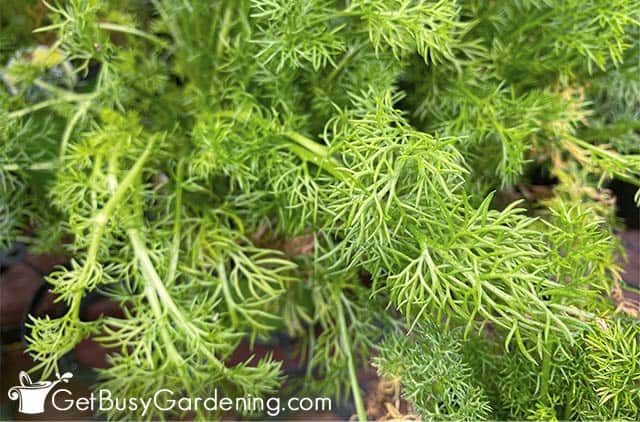
Pruning
Prune back stems with clean precision snips to 4” after the first set of flowers fade. This helps prevent leggy growth, and encourages more branching for a second set of blooms.
Picking and deadheading the flowers on a regular basis is also beneficial. It will prevent re-seeding, and encourage even more new buds to bloom.
Pest Control
Though they aren’t normally a huge problem, aphids, thrips, and mealybugs are a few of the pests that you may encounter when growing chamomile.
Treat them with natural methods, like a sharp blast of water, or insecticidal soap. I make my own by mixing 1 teaspoon of mild liquid soap with 1 liter of water.
Though neem oil is natural and will work too, be cautious about spraying it over flowers you plan to use, as it could affect the flavor.
Disease Control
There are two diseases that chamomile is most susceptible to, powdery mildew and botrytis.
Both are caused by excess moisture. Water at the base to prevent it from sitting on the foliage and flowers, and thin out plants if needed to improve air circulation.
If you begin to see signs of disease, prune away damaged leaves, or treat with a natural fungicide to keep it from spreading.
Tips For Harvesting Chamomile
The best time to harvest chamomile is when the flower petals begin to curl backward.
Snip the heads from the stalks and spread them out in a cool place to dry, which will make the flavor more potent. The foliage is also edible, but tends to have a more bitter flavor.
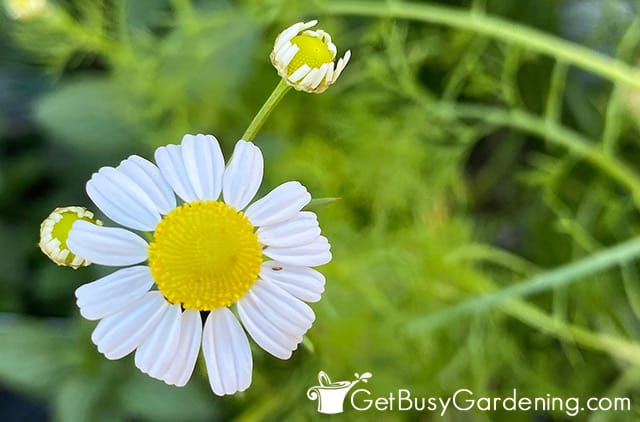
Chamomile Propagation Tips
The propagation methods for chamomile depend on the variety. Roman types can be divided or rooted from stem cuttings in the early spring.
German chamomile is naturally self-seeding. If you want them to grow back next year, allow some flower heads to remain on the plant and fully dry. New plants should emerge the following spring.
It’s also possible to collect the seeds and replant them yourself to control when and where they grow.
Troubleshooting Common Problems
Growing chamomile is hands-off in most cases, but you may still encounter one of these more common problems over time. Here are my best tips for getting them back into good health.
Plant Is Bolting / Going To Seed
Flowering is a natural, and generally encouraged, part of chamomile’s life cycle. However if yours is shooting up leggy stalks, it’s likely due to excess heat.
Provide shade during the afternoon hours if the temperatures are regularly above 85°F. Prune leggy stems back to 4” to help rejuvenate bushier growth.
Leaves Turning Brown
Brown chamomile leaves are usually a symptom of improper watering or disease. New plants need consistent moisture, but never like soggy soil.
Once you see new growth, let the soil dry out several inches down between drinks, but never to the point where the plant starts drooping. A moisture meter can help you get it just right.
Botrytis can also cause browning of the leaves. Treat it with a fungicide to prevent the spread, and trim away any affected leaves. If it gets worse, destroy the infected plant to keep it from spreading to others.
Chamomile Not Growing
If your chamomile isn’t growing, it could be caused by lack of light or temperature extremes.
They do best with 6-8 hours of full sun every day. Too little will cause stunted growth or lack of flowering.
Heat that reaches highs of 100°F will stop growth and dry it out. Give it shade and more frequent water to help protect it in the afternoon.
Cold below 65°F will slow it as well, and temperatures below 30°F will stop it completely.
Yellow Leaves
Yellowing can be caused by several things, primarily overwatering, lack of nutrients, disease, or pests.
Never water to the point of making the soil soggy, and let it dry between drinks. Water near the roots to avoid excess moisture sitting on the leaves as well.
Check for pests, and treat them right away. If none of these are the issue, the soil may be lacking nutrients. Add a dose of balanced fertilizer to help rejuvenate it.
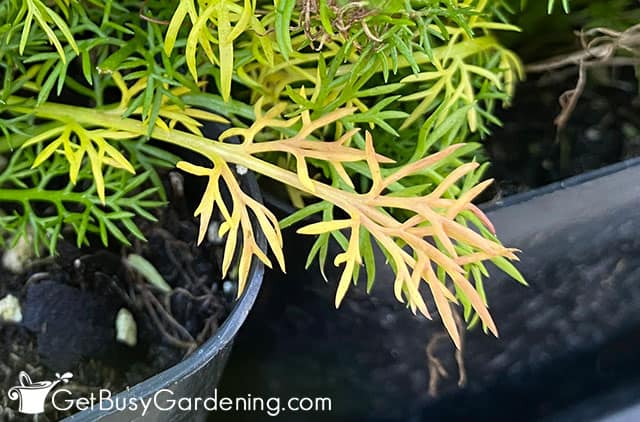
FAQs About Growing Chamomile
Here I’ve answered some of the most commonly asked questions about chamomile plant care. If yours isn’t on the list, please add it to the comments section below.
Is chamomile easy to grow?
Chamomile is easy to grow because it’s drought tolerant and can adapt to a wide variety of soils, temperatures, and both sun and partial shade.
How long does chamomile take to grow?
Chamomile usually takes about 60-65 days to grow from seed to harvest. This can fluctuate depending on the care, environment, and type you have.
Does chamomile grow back every year?
Roman chamomile is a perennial that will grow back every year from underground rhizomes. German chamomile doesn’t grow back from the same plant, but can self seed and generate new plants the following spring.
Where does chamomile grow best?
Chamomile grows best in well draining soil and an area that receives at least 6 hours of direct sunlight.
Does chamomile prefer sun or shade?
Chamomile prefers full sun unless you live in a warm climate that regularly receives temperatures higher than 85°F. In those regions, it prefers partial shade in the afternoon.
With the care tips in this guide it’s easy to see how simple growing chamomile can be, even for beginners. With enough light and occasional watering, it’s a low-maintenance, beautiful plant to include in your garden.
If you’d like to learn how to make the most of your space and get as much homegrown food as possible, then my Vertical Vegetables book is perfect! It will teach you all you need to know, has tons of gorgeous inspirational photos, and 23 DIY projects you can build for your own garden. Order your copy today!
Learn more about my Vertical Vegetables book here.
More About Herb Gardening
- How To Grow Marjoram At Home
- How To Grow Tarragon At Home
- How To Grow Stevia At Home
- How To Grow Thyme At Home
Share your tips for growing chamomile in the comments section below.


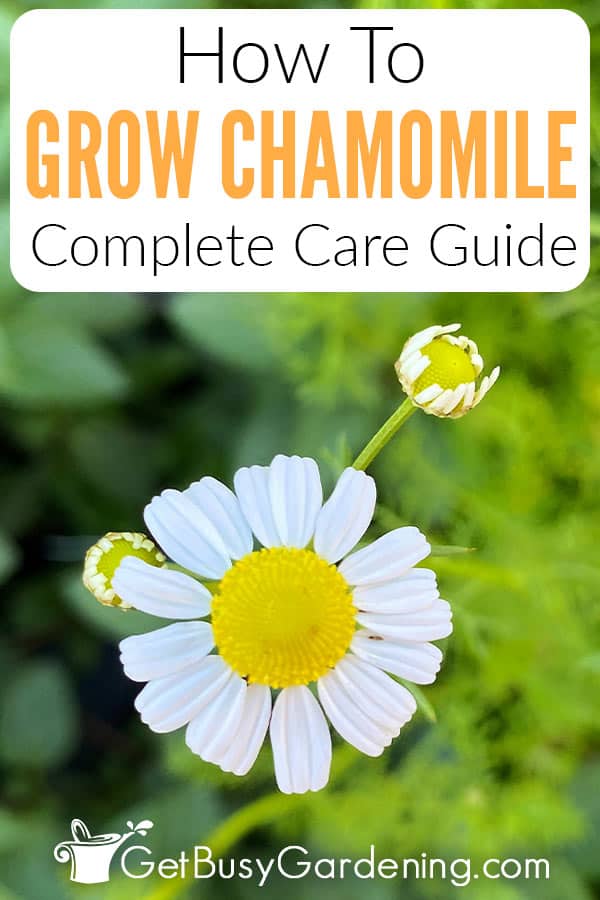



Rebecca Cotton says
When roman chamomile grows up into new plants in the spring, can the old plants get dug up? Only i have one that so far nothing has grown on the old plant but about 5 new plants have sprouted near it.
Amy Andrychowicz says
Yes, if the main chamomile plant has died, then you can certainly pull it out or dig it up.